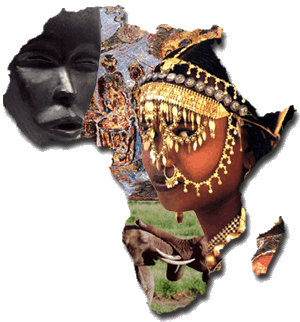 There have been many misconceptions about the lives of Africans before the advent of European and American colonization. According to some historians, Africans were nothing more than savages whose only contributions to the world were farming and slaves. However, this is not true. The history of ancient Africa is just as interesting, complex, and sophisticated as any other ancient civilization, yet almost without exception; only Egypt receives any consideration when writing about the history of Africa. Because of this mentality, European and American historians have long espoused that Africa and its inhabitants had no culture or history of their own, except what was given to them by outside factors.
There have been many misconceptions about the lives of Africans before the advent of European and American colonization. According to some historians, Africans were nothing more than savages whose only contributions to the world were farming and slaves. However, this is not true. The history of ancient Africa is just as interesting, complex, and sophisticated as any other ancient civilization, yet almost without exception; only Egypt receives any consideration when writing about the history of Africa. Because of this mentality, European and American historians have long espoused that Africa and its inhabitants had no culture or history of their own, except what was given to them by outside factors.
However, long before the colonization of Europeans, Africans built kingdoms and monuments that rivaled any European monarchy. Nevertheless, because of racial prejudice, much of Black African history has been distorted and ignored to give justification to the enslavement of millions for financial profit. This article will discuss the ancient African kingdoms of Meroë, Ghana, and the Swahili and their rich contributions to the pages of history.
The kingdom of Meroë started around 1000 BCE when Nubian rulers built up a politically independent state known to the Egyptians as Kush. Eventually, the rulers of Kush would move to Nubia and establish the kingdom of Meroë (Davis & Gates p. 30). These rulers established their capital at Meroë around 300 BCE, and the kingdom lasted there for more than nine centuries.
However, some historians feel that because Meroitic culture imitated the Egyptian culture so closely, the Meroitës brought no culture of their own to the pages of history. This is not true According to archaeological evidence discovered in North Sudan that is over 2,500 years old, there lived a civilization along the Nile River at lower and Upper Nubia (modern day Sudan) that was older than the civilizations in the North (Egypt). Also, there is evidence that proves that the known Old Egyptian Civilization was an advanced stage of an even older civilization located in the Sudan (Davis & Gates, p. 35).
This evidence proves that Meroë had a culture and history that was even older than of the Egyptians. If anything, Egypt was a carbon copy of Meroë. This kingdom also had its own language. Most historians however, attributed their language and alphabet system to the Egyptians. It was a common belief that ancient Black Africans could not and did not develop a written language. However, inscriptions in a distinct indigenous alphabet appear in Meroë as early as the 2nd century B.C, proving that these assumptions are not true (Davis & Gates, p. 110).
This written Meroitic language was used into the 5th century, when Old Nubian eventually replaced it. Widespread use of Meroitic on monuments indicates that a significant percentage of the population was able to read it. However, the meanings of these inscriptions remain unknown, as this hieroglyphic-derived script is as yet untranslatable.
Another little known fact about the Meroitës is that they had an unusually high number of queens who ruled without male intervention. One queen, Queen Amanirenus led her army against a Roman invasion in 24 BCE. She won two battles and after that, the Romans had had enough and agreed to a truce and went back to Rome. Rome never did conquer Meroë, and this kingdom continued to thrive for another 200 years. Actually, “queendom” would be more accurate, since the leader of Meroë was usually a warrior queen, called a “kandake” which means “queen mother” or more simply “gore” meaning ruler”(Fairservis. p.60).
In terms of economics, Meroë was famed for its massive iron production, the first large-scale industry of its kind in the Nile Valley and had extensive trade with Greece and Rome. Because of the production of iron, the armies had better weapons to use during battle and the farmers had better axes and hoes to work their lands. Meroitë traders exported ivory, leopard skins, ostrich feathers, ebony, and gold and soon gained direct access to the expanding trade of the Red Sea (Shillington, p. 40).
The kingdom of Meroë eventually went into decline. Causes for the decline of the Meroitic Kingdom are still largely unknown. The Meroitic kingdom faced formidable competition because of the expansion of Axum, a powerful Abyssinian state in modern Ethiopia to the east. About 350 CE, an Axumite army captured and destroyed Meroe city, ending the kingdom’s independent existence.
 The West African Empire of Ghana is another kingdom whose history was downplayed and attributed to outside factors. Although the Berbers originally founded Ghana in the fifth century, it was built on the southern edge of Berber populations. In time, the land became dominated by the Soninke, a Mande speaking people who lived in the region bordering the Sahara (McKissack & McKissack, p. 112). They built their capital city, Kumbi Saleh, right on the edge of the Sahara and the city quickly became the center of the Trans-Saharan trade routes.
The West African Empire of Ghana is another kingdom whose history was downplayed and attributed to outside factors. Although the Berbers originally founded Ghana in the fifth century, it was built on the southern edge of Berber populations. In time, the land became dominated by the Soninke, a Mande speaking people who lived in the region bordering the Sahara (McKissack & McKissack, p. 112). They built their capital city, Kumbi Saleh, right on the edge of the Sahara and the city quickly became the center of the Trans-Saharan trade routes.
Ghana accumulated great wealth because of the Trans-Saharan trade routes. This wealth made it possible for Ghana to conquer local chieftaincies and demand tribute from these subordinate states. This tribute, however, paled next to the wealth generated by the commerce of goods that passed from western Africa east to Egypt and the Middle East. This trade primarily involved gold, salt, and copper (Koslow, p. 70).
A hereditary king called the Ghana ruled Ghana. The kingship was matrilineal (as were all Sahelian monarchies to follow); the king’s sister provided the heir to the throne (McKissack & McKissack, p. 115). In addition to military power, the king appears to have been the supreme judge of the kingdom.
Although northern African had been dominated by the religion of Islam since the eighth century, the kingdom of Ghana never converted (McKissack & McKissack, p. 120). The Ghanaian court, however, allowed Muslims to settle in the cities and even encouraged Muslim specialists to help the royal court administer the government and advice on legal matters.
The original founders of Ghana ultimately proved to be its demise. Unlike the Ghanaians, the Berbers, now calling themselves Almoravids, fervently converted to Islam and in 1075 CE, declared a holy war, or jihad, against the kingdom of Ghana. Little is known about what exactly happened but nonetheless, Ghana ceased to be a commercial or military power after 1100 CE. The Almoravid revolution ultimately ended the reign of Ghana.
Europeans and Arabs alike have portrayed the history of the Swahili kingdom as one of Muslim-Arab domination, with the African people and its rulers playing a passive role in the process. However, recent archaeological evidence found shows that the Swahili people are descendants of the Bantu speaking people who settled along the East African coast in the first millennium (Horton & Middleton, p. 70). Although both Arabians and Persians intermarried with the Swahili, neither of these cultures had anything to do with the establishment of Swahili civilization. These cultures became absorbed into an already flourishing African civilization founded by ancient Bantu Africans.
The eastern coast of Africa changed profoundly around the close of the first millennium CE. During this time, Bantu-speaking Africans from the interior migrated and settled along the coast from Kenya to South Africa. Next, merchants and traders from the Muslim world realized the strategic importance of the east coast of Africa for commercial traffic and began to settle there (Horton & Middleton, p. 72). Marriage between the Bantu women and men of the Middle East created and cemented a rich Swahili culture, fusing religion, agricultural architecture, textiles, food, as well as purchasing power. From 900 CE, the east coast of Africa saw an influx of Shirazi Arabs from the Persian Gulf and even small settlements of Indians. The Arabs called this region al-Zanj, “The Blacks,” and the coastal areas slowly came under the control of Muslim merchants from Arabia and Persia (Horton & Middleton, p. 75). By the 1300’s, the major east African ports from Mombaza in the north to Sofala in the south had become thoroughly Islamic cities and cultural centers.
The language that grew out of this civilization is one of the most common and widespread of the lingua franca: a lingua franca is a secondary language that is a combination of two or more languages. Swahili or Kiswahili comes from the Arabic word sawahil, which means, “coast.” Swahili belongs to the Sabaki subgroup of the Northeastern coast Bantu languages. It is closely related to the Miji Kenda group of languages, Pokomo and Ngazija (Horton & Middleton, p.110). Over at least a thousand years of intense and varied interaction with the Middle East has given Swahili a rich infusion of loanwords from a wide assortment of languages. Even with the substantial number of Arabic loanwords present in Swahili, the language is in fact, Bantu.
The Swahili civilization expanded southwards until they reached Kilwa in Zanzibar (from the Arabic word al-Zan). Later, its inhabitants carved out a small territory even further south around Sofala in Zimbabwe (Horton & Middleton, p. 140). While the northern cities remained localized and had little influence on African culture inland from the coast, the Sofalans actively went inland and spread Islam and Islamic culture deep in African territory (Horton & Middleton, p. 150).
The major Swahili city-states were Mogadishu, Barawa, Mombasa (Kenya), Gedi, Pate, Malindi, Zanzibar, Kilwa, and Sofala in the far south (Horton & Middleton, p. 155). Kilwa was the most famous of these city-states and was particularly wealthy because it controlled the southern port of Sofala, which had access to the gold, produced in the interior (near “Great Zimbabwe”), and its location as the farthest point south at which ships from India could hope to sail and return in a single monsoon season.
These city-states were very cosmopolitan for their time and they were all politically independent of one another. In fact, they were more like competitive companies or corporations, each vying for the lion’s share of African trade. The chief export was ivory, sandalwood, ebony, and gold. Textiles from India and porcelain from China were also brought by Arab traders (Horton & Middleton, p. 175). While the Arabs and Persians played a role in the growth of the Swahili civilization, the nobility was of African descent and they ran the city-states (Horton & Middleton p.195). However, the nobility were Muslims and it was the Muslims who controlled the wealth. Below the nobility were the commoners and the resident foreigners who made up a large part of the citizenry.
However, Islam itself penetrated very little into the interior among the hunters, pastoralists, and farmers. Even the areas of the coast near the trading towns remained relatively unaffected (Horton & Middleton p.198). In the towns, the mud and thatch houses of the non-Muslim common people surrounded the stone and coral buildings of the Muslim elite, and it seems that most followers of Islam were wealthy, not poor.
Still, a culture developed for the Swahili that fused African and Islamic elements. Family lineage, for example, was traced both through the maternal line, which controlled property, an African practice, and through the paternal line, which was the Muslim tradition. Swahili culture had a strong Islamic influence but retained many of its African origins.
 These city-states began to decline in the sixteenth century; the advent of Portuguese trade disrupted the old trade routes and made the Swahili commercial centers obsolete. The Portuguese wanted native Africans to have no share in African trade and busily set about conquering the Islamic city-states along the eastern coast (Horton & Middleton, p.225). In the late seventeenth century, the imam (religious leader) of Oman drove the Portuguese from the coast, and gradually established his authority over the coast.
These city-states began to decline in the sixteenth century; the advent of Portuguese trade disrupted the old trade routes and made the Swahili commercial centers obsolete. The Portuguese wanted native Africans to have no share in African trade and busily set about conquering the Islamic city-states along the eastern coast (Horton & Middleton, p.225). In the late seventeenth century, the imam (religious leader) of Oman drove the Portuguese from the coast, and gradually established his authority over the coast.
The existence of these ancient Black African civilizations proves once and for all that Africa had a culture and a history of its own other than Egyptian that endured for centuries before the advent of outside factors. The kingdom of Meroë ruled for centuries before the Egyptians and deserves its rightful place as one of the premier ancient civilizations of the world. The kingdom of Ghana proved that Africans were capable of managing their own affairs without the intervention of Europeans. The Swahili and their language were around for centuries before Arabians and others “discovered” them.
These civilizations had their own culture, language and commerce before the advent of Europeans and Muslims in Africa and for the most part, the world does not know anything about them. That is a major crime against the study of history and hopefully, through more archaeological studies and writings, the rich and interesting history of these magnificent civilizations will be told and treasured for future generations.
Bibliography
Fairservis, Jr., Walter A. The Ancient Kingdoms of the Nile. New York: Thomas Y. Crowell, 1962.
Davis, Lynn. Gates, Jr. Henry Louis. Wonders of the African World. New York: Random House Publishing, 1999.
Horton, Mark & Middleton, John. The Swahili: The Social Landscape of a Mercantile Society (Peoples of Africa). Malden, MA: Blackwell Publishing. 2001.
Koslow, Philip. Centuries of Greatness – The West African Kingdoms: 750-1900. London: Chelsea House Publishers, 1995.
McKissack, Patricia & Fredrick McKissack. The Royal Kingdoms of Ghana, Mali, and Songhay – Life in Medieval Africa. New York: Henry Holt and Company, Inc., 1994.
Shillington, Kevin. History of Africa. Oxford: Macmillan Education, 1995.
Great Ancient African Civilizations,




Garry
15 Mar 2012Not to mention, if genetic science is to be believed, we all came from Africa in long ages past. Our phenotypes converge there in the cradle of our very existence. Africa had thriving kingdoms(Egypt anyone? Egypt is in Africa) LONG before Western civilization ever began. Timbuktu (colloquially the furthest place from civilization on the planet) was once the heart of the most powerful empire on the continent.
Kato
15 Mar 2012Western history often cursorily handles African history and brushes it off in either horribly racist rhetoric or by ignoring the fact that Africa is it’s own continent with many unique countries and cultures and histories coexisting with one another.